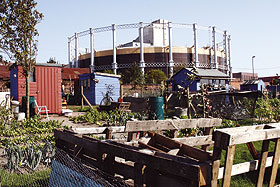
| HOME |
| NERVE |
| REVIEWS |
| ARCHIVE |
| EVENTS |
| LINKS |
| ABOUT US |
| CONTRIBUTORS |
| BACK ISSUES |
| CONTACT US |
Back to index of Nerve 9 - Autumn 2006
 Ritchie
Hunter goes back to his roots and finds an industrial landscape changed
into a green oasis - for now!
Ritchie
Hunter goes back to his roots and finds an industrial landscape changed
into a green oasis - for now!
Green Asylum
Carl Hunter (no relation) pointed to a tree that, to me, looked completely
natural. “That tree has just come from the set of the latest Bond
movie. Some of the plants here have been in countless films. They’re
all movie stars!”
We were sitting on a bench outside what looked like an asbestos shed in
the middle of an allotment, while Carl told me of the film he is making
about asylum seekers.
Everything on the site had been brought in for this film, transforming
a piece of waste ground into a lush green garden.
It was really strange for me that this allotment was on this spot in the
Dingle. Not least because I had worked for ten years at the engineering
factory which occupied the site before it was reduced to an ‘oller’.
Carl talked about how the area, with its gasometers, its flourmill, and
its view over the Mersey to the former Cammell Lairds shipyard, lent significance
to the script.
“This story is based in the north; it’s not Liverpool specific.
The allotment is a very male, white world, and a little bit on the racist
side. So the men in our story aren’t that likeable: they’re
bitter and twisted.
“Although you can’t sympathise with many of the characters
in the film you can understand why they are the way they are, and why
they come to this oasis.
“I didn’t want to cast Liverpudlians in a negative light,
because television and film has done a diabolical job of doing that since
time began. So if there is a Liverpool accent in the film they are usually
a good guy, or intelligent or very humane.
“The growing plants, the allotment, are a visual metaphor for the
lives of asylum seekers. If you prepare the ground and put the seeds in
and nurture them and the plants, eventually you will have a wonderful
crop. In the same way if you take a refugee in this country and look after
them, treat them well, they can blossom as well.
“So the refugees turn up and there is hostility from the old guard,
these grumpy ‘al gits’. Through the course of the film a friendship
starts to flourish between one of these men and a Chinese refugee –
Ken, who starts to work on one of the plots, and an understanding of the
plight of refugees grows.
“Ken was tortured in China when he had opposed the land seizure
programme and fled with his wife, who died on the journey. He is very
traumatised; so much so that he can’t speak.
“The man who befriends him also has something missing from his life.
For twenty years he has been living a lie.
“So these two are only half people. They become close friends gradually
over the course of the film, and as they come together, they become whole.
Ken starts to deal with life. He makes friends and begins to settle in,
and things gradually start coming together for him. As his plants grow
he starts to heal, and as his plot blossoms so does he.
“Then, there is a big shock to the whole site because a mobile phone
company decide that this is the perfect position for a phone mast.”
I asked Carl to stop here before he told me the entire story, and asked
him about how he came to be making the film.
“The film follows on from three mini documentaries for Channel 4,
which me and Clare Heney shot. They were based on a project run by the
Family Refugee Support Project. (See
Nerve 7). The original idea came from Frank Cottrell Boyce who has
been trying to get me to work in drama for years. But until this came
up I’ve never been able to find a story to tell. He said that by
making it a comedy it would be much more accessible. So it was his idea
and he wrote the screenplay.
“I wanted to do it because, in this right wing climate, there are
no pro-refugee films getting made. It won’t look like a British
comedy, more like a Czechoslovakian art house movie. It’s shot in
a stunning way.”
Carl and Clare are volunteers for Art in Action, a community arts project
based in Bootle. Originally Carl wanted the film to be just an Art in
Action produced film, which would’ve put all the money from it back
into what is a very poor area of Bootle.
“When the film was commissioned by the BBC a big company was brought
in to produce it, with us as co-producer. But this means we still get
an income.”
So what will happen to these allotments after the filming finishes? The
answer is a sad:
“We have to leave this place how we found it.”
So, replace the rubble, the coke cans, old prams and dog shit?
Oh, and the shed turned out to be made of pressed cardboard!
The Allotment (working title) is to be released in the autumn of 2007.
Sorry Comments Closed
Comment left by luke Smith on 7th December, 2010 at 14:46
hi, im trying to find this film, was it actually called 'the allotment' in the end?
Thanks,
Luke